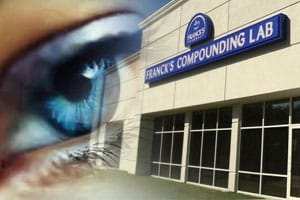
Five federal complaints allege that Franck’s Compounding Lab sold contaminated surgical dye to surgeons and that the dye either blinded patients or caused damage to their eyes, causing blinding in some patients. Franck’s Compounding Lab has been sued two times each in Los Angeles and New Orleans and once in Las Vegas. The lawsuits, said […]
 Five federal complaints allege that Franck’s Compounding Lab sold contaminated surgical dye to surgeons and that the dye either blinded patients or caused damage to their eyes, causing blinding in some patients.
Five federal complaints allege that Franck’s Compounding Lab sold contaminated surgical dye to surgeons and that the dye either blinded patients or caused damage to their eyes, causing blinding in some patients.
Franck’s Compounding Lab has been sued two times each in Los Angeles and New Orleans and once in Las Vegas. The lawsuits, said Courthouse News, were brought over Brilliant Blue G, a stain used in eye surgery that better enables physicians to see the transparent tissues in the eye during ocular surgery.
As we’ve explained, compounding involves mixing drugs using bulk ingredients, typically when patients are allergic to inactive ingredients in medicines approved by the U.S. Food and Drug Administration (FDA) or when a different dose or delivery form (cream, powder, injectable) is needed and cannot be commercially filled. Pharmacies are able to work outside of the statutory drug approval process by creating drugs via pharmacy compounding, which means that compounded drugs are not typically FDA approved.
In March 2012, the FDA received reports of fungal endophthalmitis (eye infections) in patients given Brilliant Blue G during surgery; Franck’s supplied the Brilliant Blue. Clinicians in a number of states reported the adverse events and, in April 2012, the FDA received reports of eye infections in patients given injections of Franck’s drug products containing triamcinolone during eye surgery. The FDA then warned that any product received from Franck’s since November 2011 not be used.
The FDA previously tested unopened bottles and unused syringes of the dye collected from Franck’s Compounding Lab and discovered multiple bacterial and fungal species. The agency announced that Franck’s was linked to a multi-state outbreak of a rare and serious fungal eye infection, confirming 33 cases that spanned seven states. At least 23 people suffered vision loss and 24 required repeat surgery, according to U.S. Centers for Disease Control and Prevention (CDC) figures.
Officials at Franck’s previously issued a statement indicating that they conducted a thorough investigation, tracing the contamination to a dye used in ocular triamcinolone injections and formulas containing that drug. Franck’s stated it resolved the issue and implemented changes that included hiring a new pharmacist to oversee quality assurance. Franck’s then issued one recall that involved five physicians and eight prescriptions and another recall of triamcinolone acetonide P.F. 80mg/ml, which involved four physicians and five prescriptions. Franck’s expanded its recall of compounded drugs and the FDA notified physicians and medical care organizations who ordered compounded products sold as a sterile preparation by Franck’s, of the recall, which involved all sterile products sold by Franck’s since November 2011. The CDC and the FDA then implemented separate investigations.
The most recent lawsuit was filed against Franck’s Compounding Lab and Paul W. Franck; Anthony James Campbell, a lead chemist with the lab; and Wells Pharmacy Network. This lawsuit alleges that Franck’s dye, “tainted with filth, putrid, or decomposed substances,” gave the plaintiff an infection that left him blind in one eye, said Courthouse News. The lawsuit also discussed Franck’s association with the 2009 deaths of 21 polo ponies.
As we’ve written, Franck’s was the pharmacy responsible for mixing supplements that caused the deaths of the elite polo horses. Franck’s acknowledged that it used excess selenium in a veterinarian-prescribed supplement mix; the horses’ owners have since filed a lawsuit. The FDA also previously accused Franck’s of illegally developing copies of similar drugs, of creating so-called “brews” outside of federal guidelines, and of compounding animal products from drugs not approved for use in the U.S. Franck’s was warned in 2005 and, again, in 2009, for illegal animal drug compounding. In 2011, a federal court disagreed, finding that the FDA had no jurisdiction over the established pharmaceutical practice of filling veterinary prescriptions for animals via compounding from bulk substances.


